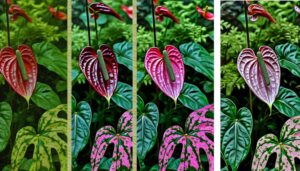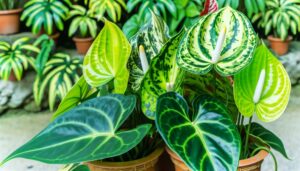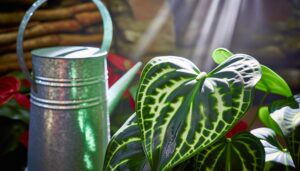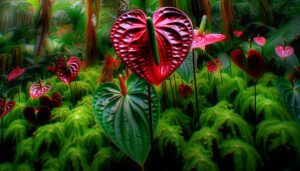Which Anthurium Hybrid Plants Are Most Popular? Top Picks!
Popular Anthurium hybrids include Anthurium ‘Clarinervium’ and Anthurium ‘Forgetii,’ known for their dark green, velvety leaves and white veins. You’ll also appreciate Anthurium ‘Crystallinum’ and Anthurium ‘Veitchii’ for their striking venation.
On the other hand, Anthurium ‘Regale‘ and Anthurium ‘Ace of Spades’ stand out due to their unique leaf shapes and bold colors. Additionally, Anthurium ‘Faustino’s Giant’ and Anthurium ‘Vitarifolium’ are admired for their impressive size and coloration.
These hybrids thrive in high humidity, indirect light, and well-draining substrates, making them favorites among plant enthusiasts. To master their care specifics, you’ll want a deeper look.
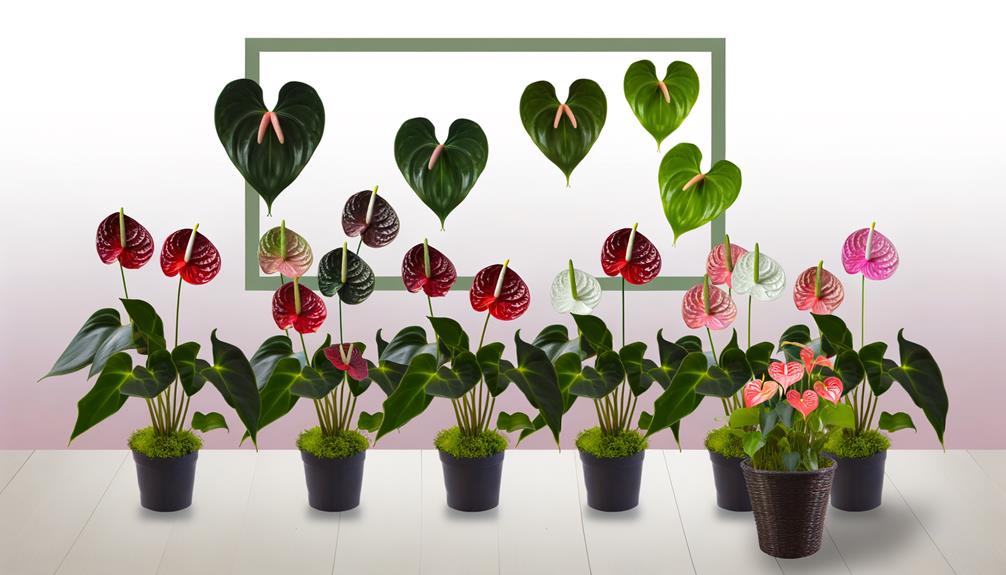
Key Takeaways
- Anthurium ‘Clarinervium’ is highly popular for its velvety leaves with striking white veins.
- Anthurium ‘Crystallinum’ attracts enthusiasts with its dark, heart-shaped leaves and prominent white venation.
- Anthurium ‘Forgetii’ is favored for its unique, rounded leaves without sinus cuts.
- Anthurium ‘Warocqueanum’, also known as the “Queen Anthurium,” is cherished for its elongated, velvet leaves.
- Anthurium ‘Ace of Spades’ stands out for its dark, almost black foliage and unique leaf shape.
Anthurium ‘Clarinervium’

Anthurium ‘Clarinervium’, a remarkable member of the Araceae family, is distinguished by its dark green, velvety leaves adorned with prominent white venation. You’ll find its heart-shaped foliage enchanting, with each leaf intricately displaying a network of veins.
This species thrives in well-draining soil rich in organic matter, ensuring excellent aeration and moisture retention. When nurturing ‘Clarinervium’, maintain high humidity levels—ideally around 60-80%—to mimic its native tropical environment. Position it in indirect, bright light to prevent leaf scorch while promoting vigorous growth.
Fertilize monthly during the growing season with a balanced, water-soluble fertilizer. By adhering to these care guidelines, you’re ensuring that your Anthurium ‘Clarinervium’ remains a stunning and healthy addition to your botanical collection.
Anthurium ‘Forgetii’
When considering Anthurium ‘Forgetii’, you’ll notice its distinctive, completely rounded leaf shape lacking a sinus, which sets it apart from other species. Understanding its care requirements, including high humidity and indirect light, is essential for best growth.
You’ll also see that this species exhibits a more compact growth pattern, making it a popular choice for indoor cultivation.
Distinctive Leaf Shape
Among the many Anthurium hybrids, the ‘Forgetii‘ stands out with its uniquely ovate leaves that lack the usual indentation, offering a smooth shift from petiole to blade. This seamless change results in an uninterrupted, elliptical foliage shape that’s visually enchanting.
When examining the venation, you’ll notice prominent, silver-white primary veins that contrast sharply against the dark green leaf surface, enhancing its ornamental appeal.
The absence of the usual indentation, which is typically seen at the petiole, sets it apart in the world of plant taxonomy. This distinct leaf morphology not only makes it a unique specimen in your collection but also highlights the botanical diversity within the Anthurium genus.
You’re embracing a piece of horticultural art with every glance.
Care Requirements
To secure the best growth of your Anthurium ‘Forgetii’, provide a well-draining, airy potting mix rich in organic matter, as this closely mimics its natural epiphytic habitat. Incorporate elements like orchid bark, perlite, and sphagnum moss to ensure prime aeration and moisture retention.
Position your plant in bright, indirect light to support photosynthesis without scorching its delicate leaves. Maintain a consistent temperature between 65-80°F, avoiding cold drafts.
Humidity should hover around 70-80%, so frequent misting or a humidifier will benefit your plant. Water when the top inch of the substrate feels dry, ensuring thorough drainage to prevent root rot.
Fertilize monthly with a balanced, diluted liquid fertilizer during the growing season to promote vigorous growth.
Growth Patterns
Understanding the growth patterns of Anthurium ‘Forgetii’ involves recognizing its unique leaf morphology and slow, steady development, which distinguishes it from other Anthurium species. You’ll notice its leaves are ovate with no sinus, a rare trait among Anthuriums. These leaves exhibit velvety textures and prominent venation, enhancing their appeal.
Growth in ‘Forgetii’ is gradual, as it prefers stable, well-draining substrates high in organic matter. You’ll see that its roots thrive in an epiphytic environment, mimicking its native tropical habitat. Regular, moderate watering keeps it healthy, but avoid waterlogging. Light requirements include bright, indirect light to prevent leaf scorching.
Anthurium ‘Crystallinum’

Anthurium ‘Crystallinum’, renowned for its striking velvety leaves with prominent white veins, belongs to the Araceae family and showcases an enchanting blend of aesthetic appeal and botanical complexity. You’ll appreciate its foliage, which boasts a dark green hue contrasted by intricate vein patterns.
This epiphytic perennial thrives in high humidity and indirect light, making it perfect for indoor environments. Its cordate leaf shape and velutinous texture provide a tactile experience that’s both unique and charming.
When it comes to care, make sure you use a well-draining, airy substrate to mimic its natural habitat. Regular misting will maintain its humidity needs. With its visually arresting foliage and relatively low-maintenance requirements, Anthurium ‘Crystallinum’ is a must-have for plant enthusiasts seeking freedom in botanical expression.
Anthurium ‘Veitchii’
Explore the world of Anthurium ‘Veitchii’, commonly known as the ‘King Anthurium,’ celebrated for its elongated, pendant leaves that can reach up to several feet in length, exuding a regal botanical presence.
This epiphytic species thrives in well-draining, organic-rich substrates, mimicking its native tropical rainforest habitat. You’ll find its veins distinctly channeled, adding texture and sophistication to its foliage. Best growth occurs under high humidity, indirect light, and temperatures between 65-80°F.
Regular misting and a balanced fertilizer during the growing season enhance importance. As a member of the Araceae family, Anthurium ‘Veitchii’ showcases inflorescences with a spadix and spathe, adding ornamental value.
Embrace the majestic allure of this plant, and you’ll elevate your botanical collection’s splendor.
Anthurium ‘Regale’

When you observe Anthurium ‘Regale’, you’ll notice its striking venation patterns that make it a standout in any collection.
To flourish, it requires specific growing conditions including high humidity, well-draining substrate, and indirect light.
Make sure you follow common care tips like maintaining consistent moisture levels and providing occasional fertilization to promote peak growth.
Striking Leaf Patterns
Revered for its dramatic venation and velvety texture, the Anthurium ‘Regale’ boasts some of the most striking leaf patterns in the genus. You’ll be captivated by its large, heart-shaped leaves that feature prominent white veins contrasting against a deep green backdrop.
The intricate venation, or leaf vein pattern, showcases a reticulate pattern, enhancing its ornamental appeal. Classified under the Araceae family, Anthurium ‘Regale’ is a hybrid cultivar, prized for its unique foliage.
The adaxial (upper) surface of the leaves is velvety, providing a tactile allure, while the abaxial (lower) side maintains a matte finish. If you’re seeking a statement plant, the ‘Regale’ offers unparalleled aesthetic freedom through its stunning leaf morphology and commanding presence.
Optimal Growing Conditions
To cultivate Anthurium ‘Regale’ successfully, make certain it receives bright, indirect light to replicate its natural understory habitat.
This species thrives in a well-aerated growing medium, rich in organic matter. Incorporate components like sphagnum moss, perlite, and orchid bark to improve drainage and prevent root rot.
Maintain humidity levels around 70-80%, as Anthurium ‘Regale’ originates from tropical rainforests. Ideal temperatures range from 65°F to 75°F (18°C to 24°C), avoiding cold drafts and sudden temperature fluctuations.
Optimize the pH level of the soil stays between 5.5 and 6.5, slightly acidic, to facilitate nutrient absorption. Regularly check the root system for signs of compaction and adjust accordingly to maintain vigorous growth and overall plant health.
Common Care Tips
Maintaining the longevity and vibrancy of Anthurium ‘Regale’ involves sticking to meticulous watering practices. Let the top inch of the substrate dry out between waterings to prevent root rot.
You’ll also need to provide bright, indirect light to replicate its native understory habitat. For peak growth, maintain a consistent humidity level around 70-80%, as this species flourishes in high moisture environments.
Use a well-draining, aerated potting mix containing orchid bark, perlite, and peat to mimic its epiphytic nature.
Here are four essential care tips:
- Watering: Allow the top inch to dry out.
- Light: Provide bright, indirect light.
- Humidity: Maintain 70-80% humidity.
- Soil: Use a well-draining, aerated mix.
Following these guidelines ensures your Anthurium ‘Regale’ thrives.
Anthurium ‘Warocqueanum’
Commonly known as the ‘Queen Anthurium,’ Anthurium warocqueanum is distinguished by its elongated, velvety leaves that can grow over three feet in length, making it a prized specimen among aroid enthusiasts.
You’ll find its foliage displays a striking dark green hue with prominent white veining, a feature resulting from its unique leaf structure and chlorophyll distribution. This species thrives in high humidity and well-draining substrates, mimicking its native Colombian rainforest habitat.
To maximize growth, you’ll want to make sure bright, indirect light and maintain temperatures between 65-80°F. Anthurium warocqueanum belongs to the Araceae family, and its botanical allure lies in its epiphytic nature, allowing it to absorb nutrients directly from the air, fostering an unparalleled freedom in growth.
Anthurium ‘Magnificum’

Anthurium ‘Magnificum‘ captivates with its large, velvety, dark green leaves adorned with prominent, silvery-white veins.
You’ll find that maintaining ideal humidity levels and providing well-draining, organic-rich substrate are essential for healthy growth.
For pest management, regularly inspect for common threats like spider mites and mealybugs, and employ integrated pest management techniques.
Striking Foliage Characteristics
With its velvety, dark green leaves adorned with striking white veins, Anthurium ‘Magnificum’ exhibits a unique and visually enchanting foliage that sets it apart from other anthurium hybrids. This plant, a member of the Araceae family, showcases foliage that can captivate any plant enthusiast.
You’ll appreciate its:
- Leaf Texture: The leaves’ velutinous surface provides a tactile experience.
- Veining Pattern: Prominent white veins create a dramatic contrast against the deep green.
- Leaf Size: Large, heart-shaped leaves can grow up to 30 cm, making a bold statement.
- Leaf Shape: Its cordate leaves aren’t just large but also elegantly shaped.
These characteristics make Anthurium ‘Magnificum’ a must-have for your collection, offering both aesthetic and botanical appeal.
Care and Maintenance Tips
To guarantee Anthurium ‘Magnificum’ thrives and maintains its striking foliage, you’ll need to provide specific care centered around its native tropical environment. Ensure high humidity levels, ideally between 60-80%, by using a humidifier or pebble tray.
Position your plant in bright, indirect light to mimic its natural understory habitat. Water it thoroughly but allow the top inch of soil to dry out between waterings, preventing root rot. Utilize a well-draining, chunky substrate, rich in organic matter like orchid bark and perlite.
Fertilize monthly with a balanced, diluted liquid fertilizer during the growing season. Lastly, maintain temperatures between 70-85°F, protecting your Anthurium from drafts and sudden temperature shifts. Follow these guidelines, and your Anthurium ‘Magnificum’ will flourish.
Anthurium ‘Ace of Spades’
Distinguished by its velvety, nearly black foliage, the ‘Ace of Spades’ cultivar stands out within the diverse Anthurium genus for its unique leaf morphology and striking color contrast. You’ll appreciate its alluring aesthetics, which are due to the deep, heart-shaped leaves that draw you in. This cultivar’s leaves can reach impressive sizes, making it a focal point in any collection.
To ensure ideal growth, consider the following:
- Light Requirements: Prefers bright, indirect light.
- Humidity Levels: Thrives in high humidity environments.
- Soil Composition: Needs well-aerated, loose soil with good drainage.
- Watering Schedule: Keep soil consistently moist but not waterlogged.
Anthurium ‘Faustino’s Giant’
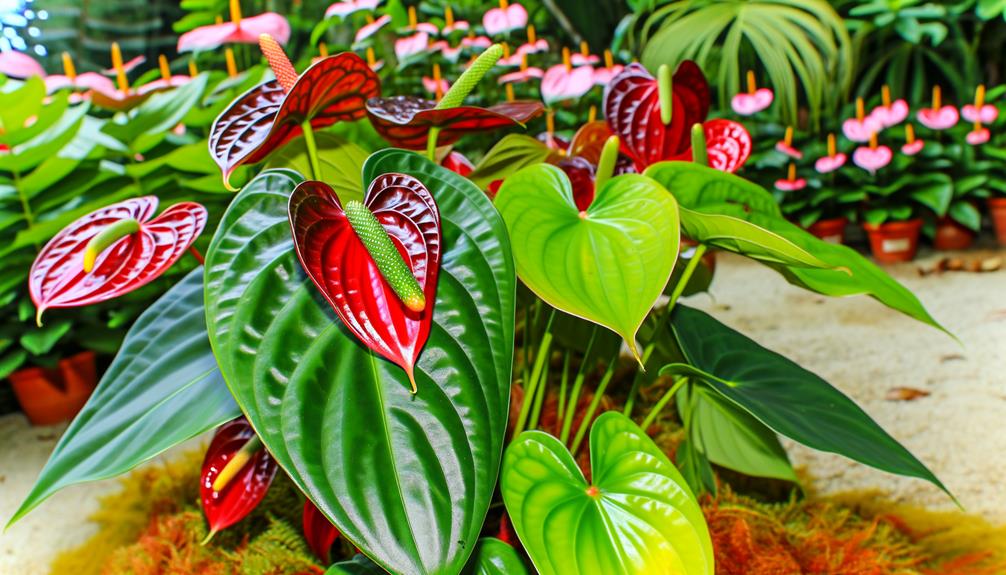
Equally alluring, the Anthurium ‘Faustino’s Giant’ stands out with its massive, deeply lobed leaves that command attention in any setting. This hybrid, an exceptional member of the Araceae family, showcases leaves that can reach up to three feet in length, making it a true botanical spectacle.
The foliage features a dark green hue with prominent veining, adding to its dramatic appearance. You’ll appreciate its robust growth habit; it thrives in well-draining, organic-rich substrates. Partial shade conditions are ideal for this plant, ensuring it remains lush while avoiding leaf burn.
With proper humidity levels and regular fertilization, ‘Faustino’s Giant’ will flourish, bringing a touch of the wild, untamed beauty of tropical rainforests into your space.
Anthurium ‘Vitarifolium’
Anthurium ‘Vitarifolium’ captivates with its elongated, strap-like leaves that can grow over four feet long, presenting a striking, architectural form. This hybrid, a member of the Araceae family, thrives in well-draining, organic-rich substrates. The leaves exhibit a leathery texture, enhancing both aesthetic appeal and durability.
For best growth, ensure:
- Humidity: Maintain moisture levels at 60-80% to mimic its native tropical habitat.
- Light: Provide ample, indirect light to avoid leaf scorching.
- Watering: Water consistently but allow the topsoil to dry out between watering to prevent root rot.
- Fertilization: Use a balanced, slow-release fertilizer during the growing season.
Anthurium ‘Renaissance

With its robust, heart-shaped leaves and striking venation, the hybrid Anthurium ‘Renaissance’ exemplifies the intricate beauty and resilience characteristic of the Araceae family. You’ll appreciate its coriaceous leaf texture and pronounced venation, which enhance its ornamental appeal.
As a member of the Anthurium genus, this hybrid inherits traits from both epiphytic and terrestrial ancestors, thriving in well-draining, organic-rich substrates. The ‘Renaissance’ cultivar’s adaptability to various light conditions, from bright indirect to partial shade, makes it a versatile addition to your collection.
Its inflorescences, composed of spathes and spadices, bring a unique aesthetic to your living space. By understanding its care requirements—consistent humidity, moderate watering, and balanced fertilization—you’ll cultivate a stunning, resilient specimen that embodies botanical elegance.
Conclusion
In your quest to cultivate the most exquisite Anthurium hybrids, you simply can’t ignore these botanical marvels. Each one, from the resplendent ‘Clarinervium’ to the awe-inspiring ‘Faustino’s Giant’, offers unparalleled beauty and a touch of horticultural sophistication.
These cultivars aren’t just plants; they’re living masterpieces, each with its own unique allure and intricate leaf morphology. Immerse yourself in the world of Anthurium hybrids, and you’ll find yourself amidst a veritable Eden of unparalleled botanical splendor.


